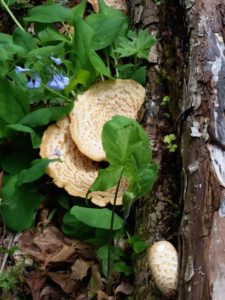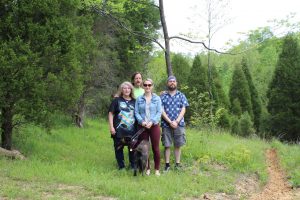About thirty years ago, my husband and I and our toddler son moved to a thirty-three acre farm in Crawford County, Indiana. There was and still is a small field by the house and a five acre hill behind the house had been used to grow corn and was badly eroding. A small wetland on the other side of the hill had also been farmed and was growing up in grasses and water cress, while another five-acre patch had been used for corn and soybeans. Finally, the patch of old forest that was left had been logged and the upper portion had been fenced for pigs.
But it was beautiful to us. My husband had grown up playing and wandering the woods of northern Mississippi and I had done the same in my Kentucky woods. I had watched my woods come crashing down to become a suburb. No trace of it remains except for a small bag of compost taken from the rotting heart of an ancient fallen oak tree I had played on once. I have a glass pendant that I wear it in.
The first thing we did here was to leave the land alone as much as possible. As soon as and whenever we could afford to, we bought Forest Service trees and wildlife packets of shrubs and began planting them by the hundreds. My husband would often do it in the rain, head bowed, digging holes in a downpour. I sprouted seeds when I could get them such as Osage orange. There are three nice sized ones now dropping their ‘oranges’ to roll into the creek and sprout on creek banks as their ancestors once did.
It has been slow, but the hillside, which is drier because of runoff, is a forest of cedars now. Where we could once climb the hill and see far into the distance, we see only trees and many oaks and other forest trees are coming back among the conifers, protected by them, moisture held for them by cedars and Witch’s Broom grass. The little wetland has a small forest of mostly walnut but also some cherry and tulip poplar. Wild grapevines are a constant problem there and walks with a machete help a little.
And there is a beautiful patch of bluebells along the creek.
 The other five acres was still being farmed and we let them use the land a few more years until we realized how much it was depleting the soil and let it grow, too. The young forest there of poplar, sycamore, oak and all is so thick that a deer ten feet in is invisible. The old woods is now carpeted every year with twin leaf, yellow root, blood root trillium, four kinds of violet, may apple, and so much more. Deer and turkey are plentiful. It is beautiful.
The other five acres was still being farmed and we let them use the land a few more years until we realized how much it was depleting the soil and let it grow, too. The young forest there of poplar, sycamore, oak and all is so thick that a deer ten feet in is invisible. The old woods is now carpeted every year with twin leaf, yellow root, blood root trillium, four kinds of violet, may apple, and so much more. Deer and turkey are plentiful. It is beautiful.
My husband kept a small path mowed as the fields were growing up and added them to an old covered wagon road already cutting through the woods, and now there is about a mile long trail that I walk every day.
A lot of plants have found their way back without our help and there is diverse wildlife here, but I have walked woods since I was a kid and I really believe the canary in the cage in the woods, here at least, are the insects. There are acres of oaks and I almost never see a stag horn beetle. When I was young, rhinocerous beetles would drop out of their trees and felt like golf balls hitting with their weight. I haven’t seen one in almost thirty years.
Mantids are not as numerous. Many of the trees are blighted. I think it’s the older trees that hold it all together. We know now from scientific discoveries that the older trees give strength underground against insects and diseases to the younger, weaker trees. Taking the older trees can almost be compared to taking the parents of the forest when they are still needed. Many of the trees here are now huge and stately and maybe that will help the others coming along.
On the other side of the creek from us, people use no-till and what must be GMO corn and soybeans and the runoff goes into the creek. I suspect that’s part of the insect problem.
Here, at the new house we have recently built, all water is saved from rain on the roof and used, solar powers most of the house and all cleaners in the house are eco-friendly. The vegetable garden in front of the house, a clay pan three years ago, is rich dark soil built up by compost and manure. It’s all organic and honeybees are seen all summer. A feeder by some cedars keeps many birds happy and safe from hawks.
People who come out here say they feel at peace and tell us we should start a retreat or something like that. They love walking the trail. For years out here, we lived with our son, then daughter, in an old, run-down farmhouse that leaked and molded but it was surrounded always by trees and we were happy.
No one of us or even a small group can save all the great forests of the world anytime soon, but we can each create some small oasis around ourselves and invite nature in and, if we’re lucky, we can connect these oases to others. I once made a promise to an old tree as I was gathering up some mulch from its interior that I would help some trees next time and being able to do that is one of the greatest feelings I know.
May we all become planters of trees and voices for them as well.
Both our kids are grown now and are gardeners. Everywhere they have lived, they have planted and every spring, they plant again.
Thank you so much people of the Indiana Forest Alliance and all who help them for being there for the trees and hope for future generations of forests and all who will enjoy them. What a wonderful act of love.
Lyn Humphries has been married thirty-seven years to Arvin Humphries. They live in central Crawford County with a dog, a horse, three goats, and two cats.

